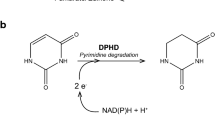Abstract
In an analysis of the effects of various tryptophan and indole analogues in Saccharomyces cerevisiae we determined the mechanisms by which they cause growth inhibition:
4-Methyltryptophan causes a reduction in protein synthesis and a derepression of the tryptophan enzymes despite of the presence of high internal levels of tryptophan. This inhibition can only be observed in a mutant with increased permeability to the analogue. These results are consistent with but do not prove an interference of this analogue with the charging of tryptophan onto tRNA.
5-Methyltryptophan causes false feedback inhibition of anthranilate synthase, the first enzyme of the tryptophan pathway. This inhibits the further synthesis of tryptophan and results in results in tryptophan limitation, growth inhibition and derepression of the enzymes. Derepression eventually allows wild type cells to partially overcome the inhibitory effect of the analogue.
5-Fluoroindole is converted endogenously to 5-fluorotryptophan by tryptophan synthase. Both endogenous and externally supplied 5-fluorotryptophan are incorporated into protein. This leads to intoxication of the cells due to the accumulation of faulty proteins. 5-Fluorotryptophan also causes feedback inhibition of anthranilate synthase and reduces the synthesis of tryptophan which would otherwise compete with the analogues in the charging reaction.
Indole acrylic acid inhibits the conversion of indole to tryptophan by tryptophan synthase. This results in a depletion of the tryptophan pool which, in turn, causes growth inhibition and derepression of the tryptophan enzymes.
Similar content being viewed by others
Abbreviations
- cpm:
-
counts per minute
- OD:
-
optical density at 546 nm
- TCA:
-
trichloro acetic acid
- tRNA:
-
transfer ribonucleic acid; trp1 to trp5 refer to the structural genes for the corresponding tryptophan biosynthetic enzymes
- trpl− res. trp1± :
-
refer to mutant strains synthesizing completely resp. partially defective enzymes
References
Delforge, J., Messenguy, F., Wiame, J. M.: The regulation of arginine biosynthesis in Saccharomyces cerevisiae. The specificity of argR-mutation and the general control of amino acid biosynthesis. Eur. J. Biochem. 59, 231–239 (1975)
Fantes, P., Roberts, L. M., Hütter, R.: Free tryptophan pool and tryptophan biosynthetic enzymes in Saccharomyces cerevisiae. Arch. Microbiol. 107, 207–214 (1976)
Gibson, F.: Preparation of chorismic acid. In: Methods in enzymology, Vol. 17A (H. Tabor, C. W. Tabor, eds.), pp. 362–364. New York-London: Academic Press 1970
Gibson, F., Pittard, J.: Pathways of biosynthesis of aromatic amino acids and vitamins and their control in microorganisms. Bact. Rev. 32, 465–492 (1968)
Herbert, D., Phipps, P. J., Strange, R. E.: Chemical analysis of microbial cells. In: Methods in microbiology, Vol. 5B (J. R. Norris, D. W. Ribbons, eds.), pp. 242–265. New York-London: Academic Press 1971
Hoch, S. O., Roth, C. W., Crawford, I. P., Nester, E. W.: Control tryptophan biosynthesis by the methyltryptophan resistance gene in Bacillus subtilis. J. Bacteriol. 105, 38–45 (1971)
Kradolfer, P., Zeyer, J., Hütter, R.: Domnant regulatory mutants in chorismate mutase of Saccharomyces cerevisiae. FEMS Microbiol. Lett. 2, 211–216 (1977)
Manney, T. R., Duntze, W., Janosko, N., Salazar, J.: Genetic and biochemical studies of partially active tryptophan synthetase mutants of Saccharomyces cerevisiae. J. Bacteriol. 99, 590–596 (1969)
Matchett, W. H.: Inhibition of tryptophan synthetase by indole acrylic acid. J. Bacteriol. 110, 146–154 (1971)
Miozzari, G.: Tryptophan-Synthese in Saccharomyces cerevisiae. Regulation der Synthese-Leistung “in vivo”. Dissertation Nr. 5698, Eidgenössische Technische Hochschule Zürich, 104 S. Zürich: aku-Fotodruck 1976
Niederberger, P.: Die allgemeine Kontrolle der Aminosäure-Biosynthese bei Saccharomyces cerevisiae. Dissertation Nr. 5882, Eidgenössische Technische Hochschule Zürich, 91 S. Zürich: Juris 1977
Pringle, J. R., Mor, J. R.: Methods for monitoring the growth of yeast cultures and for dealing with the clumping problem. In: Methods in cell biology, Vol. XI (D. M. Prescott, ed.), pp. 131–168. New York-London: Academic Press 1975
Schürch, A. R., Miozzari, G., Hütter, R.: Regulation of tryptophan biosynthesis in Saccharomyces cerevisiae: Mode of action of 5-methyltryptophan and 5-methyltryptophan-sensitive mutants. J. Bacteriol. 117, 1131–1140 (1974)
Schürch-Rathgeb, Y.: Der trp3-Locus von Saccharomyces cerevisiae. Dissertation, ETHZ No. 4828. Arch. Genet. 45, 129–192 (1972)
Smith, O. H., Yanofsky, C.: Enzymes involved in the biosynthesis of trytophan. In: Methods in enzymology, Vol. 5 (S. P. Colowick, N. O. Kaplan, eds.), pp. 794–806. New York-London: Academic Press 1962
Sommerville, R. L., Yanofsky, C.: Studies on the regulation of tryptophan biosynthesis in Escherichia coli. J. Mol. Biol. 11, 747–759 (1965)
Wolfner, M., Yep, D., Messenguy, F., Fink, G. R.: Integration of amino acid biosynthesis into the cell cycle of Saccharomyces cerevisiae. J. Mol. Biol. 90, 273–290 (1975)
Author information
Authors and Affiliations
Rights and permissions
About this article
Cite this article
Miozzari, G., Niederberger, P. & Hütter, R. Action of tryptophan analogues in Saccharomyces cerevisiae . Arch. Microbiol. 115, 307–316 (1977). https://doi.org/10.1007/BF00446457
Received:
Issue Date:
DOI: https://doi.org/10.1007/BF00446457




